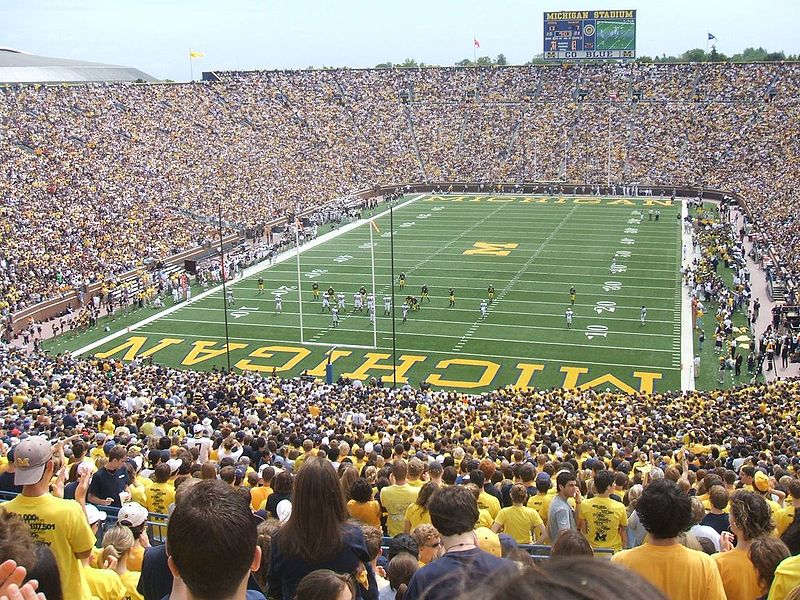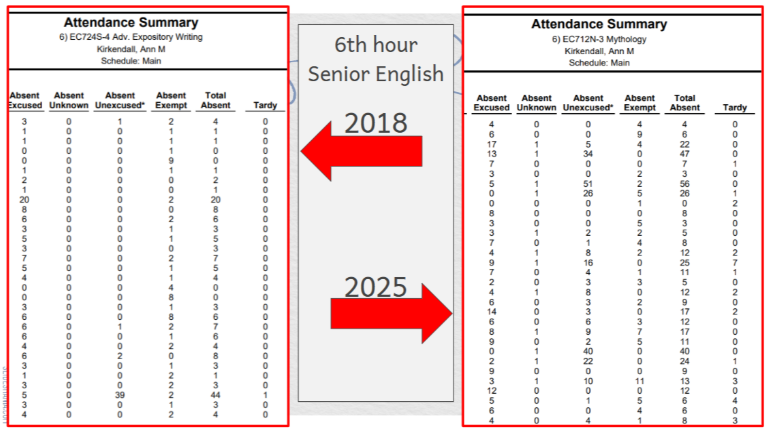The rivalry that defines the state of Michigan
November 14, 2022
“Oh there’s trouble with the snap!”
A phrase instantly recognizable to any Michigan or Michigan State fan. The play call is immortalized within the rivalry that has gripped the state of Michigan for as long as the two teams have played.
Say it to a Michigan fan, they will cringe, get angry, or have a visible wave of sadness come over them.
Mention it around a State fan, and a smile forms almost immediately. Many can even recite the play call by heart.
This is only a single moment from one of the greatest rivalries in college football. A rivalry that has dated nearly 125 years, and has seen some of the greatest moments, upsets, and pure tension college football has to offer. Every time the two teams suit up to face each other, emotions on the field, and across the state, boil high.
The week leading up to the game, fans don their colors of choice: green and white or maize and blue. Supporters see each other on the street. Sometimes it’s a playful jeer, other times a not so civil action. Few things can divide a state as easily, a hatred that goes year-round, and high stakes that affect not only bets, but friendships.
Each year the winning team is awarded the Paul Bunyan trophy. Calls to “bring Paul home” echo for the team that does not possess the trophy, while the other works to “keep Paul where he belongs”.
Even though the Wolverines took “Paul” home this year, the game was as hyped as usual. With Michigan taking the game by 22, and not allowing the Spartans inside the redzone after the first quarter, the game got away from the Spartans in a hurry.
Sadly, the game was tainted by a violent altercation post-game in the locker room hallway. The scuffle could have been due to lack of security and rising tensions between the two teams, but the aftermath resulted in two Michigan players attacked by various members of the Michigan State team.
The incident remains controversial as more video evidence of the quarrel comes out, showing a serious problem. The rivalry has seen its fair share of anger and tension. In 2016 Michigan’s Devin Bush took the center of the field and tore up the Spartan’s logo before the game, leading to multiple fights between players.
There’s been instances of vandalism with the MSU’s Spartan statue and U-M’s Diag, which has led these landmarks to be protected by students on the campuses during the week leading up to the game. These types of incidents are evidence as to just how deep this rivalry goes, and some of the violence and destruction that comes with it.
One question that is consistently asked is: are you a Michigan or Michigan State fan? The answer given has a serious effect on how we see one another for better or for worse (often for the worse).
Sr. Connor Wooley is an extreme Michigan fan with numerous memories of the game since his first encounter of the rivalry. With a glance into his wardrobe, one could immediately know where his allegiance lies. He has attended games for years, and was raised watching the Maize and Blue, “Being raised in a Michigan household, the rivalry was placed upon me pretty much at birth. I’ve always known that the Spartans are the team to root against,” Wooley said.
The rivalry is something that is passed down from generation to generation. Hatred of the other team is modeled to children from a very young age as parents push their team views to them like a religion. Parents’ memories become their children’s memories, and thus, the cycle continues.
With the rivalry taken so seriously, friendships are often caught in the crossfire. However, Wooley understands friendships should be more important than the big game, “The rivalry hasn’t gone as far as to me losing friendships with MSU fans; no rivalry should. While I may be a little more hostile towards my Spartan friends a couple of weeks out of the year, it’s nothing personal,” Wooley said. “The rivalry should stay towards football and what happens on the field, nothing else.”
Losing the big game often has a lot of consequences. It’s no wonder why it is so painful to the fanbase that is saddled with the loss, “While it is painful, I’ll never be able to forget the game seven years ago when Michigan lost on the muffed punt. Watching what would’ve been a statement win that year slip out of our hands [literally] was horrifying. The words, ‘Oh, and he has trouble with the snap,’ are engraved into my head. I remember the following week at school being absolutely miserable, full of remarks from my State friends,” Wooley said.
Roland Pakonen, an MSU season ticket holder since 1978, has been attending MSU games since 1965, his first while still an undergrad student at Michigan Tech. He has been to every MSU vs. U-M games played at Spartan Stadium since 1978, including two games played at the Big House.
One of Pakonen’s fondest memories of the game is from one of his trips to the Big House in 1978, where he attended with two of his close friends, one, Dave Lovejoy, being a graduate of U-M.
“Maybe the best experience I had was in 1978 when MSU defeated U-M in Ann Arbor when Ed Smith (QB) and Kirk Gibson lit up the Michigan secondary,” Pakonen said. “I was fortunate enough to get two tickets from a fellow in Cass City. I rode to the game in a Motor Home filled with Michigan fans. I was the only MSU fan amongst the 12 people.”
Not only was Pakonen in a hostile environment to begin with, but his tickets for the game were within the Michigan student section. Within a sea of maize and blue stood the lone specks of green and white.
“It was a good day to be Green,” Pakonen said in relation to the Spartan victory, “Nice ride back to Cass City as well that day in the Motor Home.”
Attending as many games as he has, Pakonen has seen all kinds of interactions between Spartans and Wolverines, “For the most part, fans have been relatively positive,” Pakonen said.
However, there have been times where he has seen tensions boil over, “[The] only major negative experience was a couple of years ago when Felton Davis injured his Achilles tendon at MSU and one Michigan fan stood up in our section a few rows down from our season tickets and started cheering because of the injury,” Pakonen said. “Quite obviously he received a lot of negative attention from fans in our section. He was removed from the seats by security.”
For Pakonen, the rivalry runs deep, “The positive experiences from U-M fans have pretty much been from the above mentioned Mr. Lovejoy. Most Michigan fans have pretty much boasted after wins and lay pretty low when the Wolverines lose,” Pakonen said.
Former University of Michigan football player and WO graduate Rob Renes, who played four years for the maize and blue, also possesses lots of experience in the rivalry. The game remains of high importance for himself and the team, “for those on the field, it is more than a game, It’s PERSONAL,” Renes said.
As a player, Renes saw the game from a perspective few others can say they’ve experienced, “The atmosphere at both Michigan Stadium and Spartan Stadium is electric during the Michigan MSU game. There was quite a bit of ‘chippiness’ and some trash talking,” Renes said.
Renes continued on the importance of the game within the state of Michigan, “I think the importance of this game has ebbed and flowed over the years. The rivalry is most important to the fanbase of whichever schools doesn’t have ‘Paul’ at that given point in time,” Renes said.
The Paul Bunyan trophy stays in the minds of the players throughout and after the season. A loss can define a season, and an unwanted outcome can live with the players for years to come. Renes found this out the hard way.
“No loss is easy, and as a player from the State of Michigan, I think a loss to your in-state rival sticks with you more than other losses,” Renes said, “In 1999, my senior year, we lost to MSU [at MSU]. Their coach was Nick Saban. Losing to MSU, during my last game against them, still ‘haunts’ me.”
Moving from the playing field to watching from the sidelines was not an easy transition for Renes, “I think the biggest difference between playing in the game and watching it is the frustration that can come with not having an opportunity to impact the outcome. I can cheer as much as I want to at the game, but it is the players who have to bring Paul home,” Renes said.
Loyalty is everything in the rivalry. No matter how the season is going, Renes stays with his team, “I root for Michigan every game. For this game, the Notre Dame game, and the Ohio [State] game, I have a little extra ‘enthusiasm’,” Renes said.
After the recent incidents, there are questions on where the rivalry is going. As those involved know it, how the game is experienced may have changed into a new, not yet certain direction.
As Renes sees it, “I think the importance of this game has ebbed and flowed over the years. I think the game is most important to the fan base of whichever school doesn’t have “Paul” at that given point in time,” Renes said.
While this is true, the reality is that the disputes in the rivalry are being placed into the national limelight, with any violent altercations being viewed by millions nationwide. One’s experience at a game might be completely different now than twenty years ago. There is so much at stake not only on the field, but in the stands as well, that upon game time the state holds its breath as to what happens next.
The memories and experiences of the rivalry are what keeps it alive. Now it’s up to fans on how they want the rivalry to be remembered moving forward.




